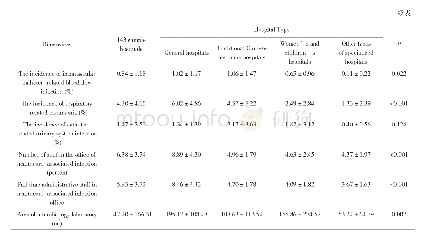《Table 2 Influence of different wheat stubble management methods, weed control treatments and their
 提示:宽带有限、当前游客访问压缩模式
提示:宽带有限、当前游客访问压缩模式
本系列图表出处文件名:随高清版一同展现
《"Weed growth, herbicide efficacy, and rice productivity in dry seeded paddy field under different wheat stubble management methods"》
1) Pendi.=pendimethalin;fb=followed by;fenox.=fenoxaprop p-ethyl;ethoxy.=ethoxysulfuron ethyl;bispyri.=bispyribac sodium.Data are mean±standard error of three replicates,and ns means non-significant.
Data regarding weed density recorded at45 DAS revealed that different wheat stubble management methods,herbicide treatments and their interaction significantly(P≤0.05)influenced total weed density in both years(Table 1,a1 and a2).Under weed-check treatment,total weed density in wheat stubble retention treatment was significantly(P≤0.05)less(43 and 45%in2013 and 49 and 58%in 2014,respectively)as compared to stubble incorporation and stubble burning treatments,respectively.Both herbicide treatments,i.e.,HC1 or HC2 performed equally well and significantly(P≤0.05)reduced the weed density by>90%in 2013(Table 1,a1)and>88%in 2014(Table 1,a2)against weed-check under all wheat stubble management methods.Data regarding total weed dry weight(Table 1,b1 and b2)revealed that only main effect of herbicide treatments was significant(P≤0.05).Both herbicide treatments performed equally well and significantly(P≤0.05)reduced weed dry weight over weed-check.HC1 reduced weed dry weight by 88%in 2013(Table 1,b1)and 86%in 2014(Table 1,b2).Weed suppression magnitude amounted to 88%in 2013 and 2014 when HC2was applied(Table 1,b1 and b2).
| 图表编号 | XD0047436300 严禁用于非法目的 |
|---|---|
| 绘制时间 | 2019.04.20 |
| 作者 | Muhammad Zia-Ul-Haq、Abdul Khaliq、Qiang Sheng、Amar Matloob、Saddam Hussain、Saba Fatima、Zeshan Aslam |
| 绘制单位 | Department of Agronomy, University of Agriculture,Faisalabad、Weed Research Laboratory, College of Life Sciences, Nanjing Agricultural University、Department of Agronomy, University of Agriculture,Faisalabad、Weed Research Laboratory, College of Life Science |
| 更多格式 | 高清、无水印(增值服务) |





